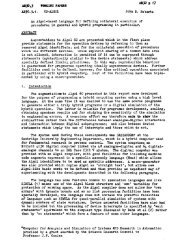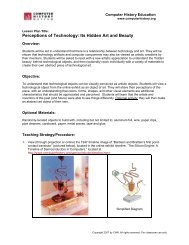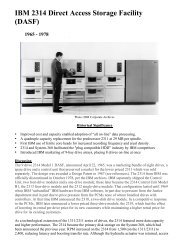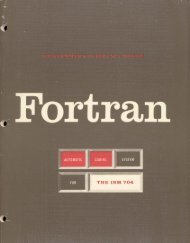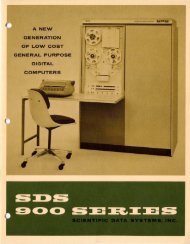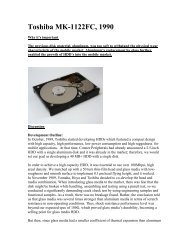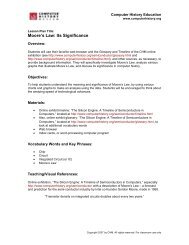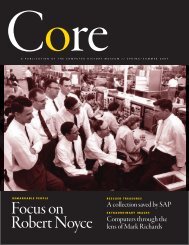PrarieTek 220 Disk Drive, 1998 - Computer History Museum
PrarieTek 220 Disk Drive, 1998 - Computer History Museum
PrarieTek 220 Disk Drive, 1998 - Computer History Museum
- No tags were found...
Create successful ePaper yourself
Turn your PDF publications into a flip-book with our unique Google optimized e-Paper software.
PrairieTek <strong>220</strong><br />
1988 PrairieTek <strong>220</strong><br />
First 2.5" disk drive<br />
Why this Is Important<br />
The advent of the 2.5" hard drive blew away the portable computers of the late 1980's which came in<br />
two forms, heavy with a 3.5" hard drive, and light with a pair of floppies. The smaller size coupled<br />
with improvements in reliability and lowering of power, created a practical mobile product and<br />
enabled a new computer industry segment. The PrairieTek <strong>220</strong> provided 20MB formatted capacity in<br />
a form factor which used 30% less space than a 3.5" drive. When volume production began in 1989,<br />
the PrairieTek <strong>220</strong> displaced 25mm high 3.5" drives in the emerging portable computer market, a<br />
category which has since grown to exceed the volume of desktop machines.<br />
Discussion<br />
PrairieTek was founded in 1986 by Terry Johnson, who had pioneered transition of the industry to<br />
smaller disk drives during the early 1980s. His earlier background in disk development included<br />
extensive experience at IBM, Memorex and Storage Technology. Johnson had been founder of<br />
Miniscribe, an early manufacturer of 5.25" and later 3.5" drives. He was a co-founder of CoData<br />
which, as noted in his Oral <strong>History</strong> (1), evolved into Conner Peripherals.<br />
Finis came up to Longmont to the guest house. He decided that he liked what John [Squires]<br />
had developed there. Finis basically came into the company and he wanted his name on the<br />
door. That was something that John and I certainly were not interested in. So it turned out that<br />
CoData became Conner Peripherals and when Finis came in the front door, so to speak, that I<br />
went out the back door.<br />
A new front door opened.<br />
I moved on and basically funded another start-up in my guesthouse this time. So there’s one for<br />
the basement and two for the guesthouse.<br />
PrairieTek <strong>220</strong> Page 1
Jim Morehouse Terry Johnson Jim Stineheifer Steve Volk Ken Jochim<br />
VP R&D Chairman President VP Sales VP Engineering<br />
Source: Jim Porter Archive<br />
The 2.5" drive departed from the practice of following the 5.25" and 3.5" FDD form factors, being<br />
designed expressly for portable applications. PrairieTek's volume production of the 25mm high<br />
PT<strong>220</strong> 20MB drive got underway in 1989, and the company's arrangement for additional production<br />
with Alps Electric started in 1990.<br />
PrairieTek <strong>220</strong> Page 2
Source: Jim Porter Archive<br />
HANNOVER, WEST GERMANY, 1990 MAR 24 (NB) -- Prairietek, the US company that<br />
developed the industry's first 2.5-inch form factor drive early last year, has released two more<br />
hard drives in the 2.5-inch format.<br />
The first drive, the Prairie 120, is an even smaller version of the 20MB Prairietek <strong>220</strong> released<br />
last year. The 120 is 21.4MB drive with a 23 millisecond access time and tips the scales at just<br />
6.4 ounces. The drive's dimensions measure and incredible 0.6 x 2.8 x 4.0 inches, including an<br />
integrated AT/XT drive controller. The 120 uses less than 1.0 watts of power. The 120's big<br />
brother, the Prairietek 240, is 42.8MB hard drive in a 2.5-inch form factor. The unit requires less<br />
than 1.5 watts.<br />
According to Steve Volk, vice president of sales and marketing with the company, the 240 is a<br />
logical step forward from the <strong>220</strong>, the first 2.5-inch drive, since it uses the same power, yet<br />
provides twice the storage capacity. This makes it ideal for use with the latest generation of<br />
80386SX-based portables currently under development.<br />
Source: http://www.ddds.tk/online/hardisk info/first 2.5 hd/the first 2.5 hd.htm<br />
JVC and Conner Peripherals were the only competitors, and the latter was first to recognize that the<br />
market was transitioning to higher capacity drives. PrairieTek's single disk 40MB model, potentially a<br />
cost-effective competitive product, was delayed by development of the 17mm PT120 and was late to<br />
market. After failing to raise sufficient cash to continue, PrairieTek ceased operations in the summer<br />
of 1991.<br />
PrairieTek <strong>220</strong> Page 3
Source: Jim Porter Archive<br />
In 1992 Conner Peripherals and Alps purchased the PrairieTek patent portfolio for $18M in a<br />
bankruptcy auction. The portfolio covered features that were commonly adopted across industry e.g.<br />
Patent # 4933785 encompassed a broad range of novel concepts including the power management<br />
capability that ATA and SCSI incorporated into their standards.<br />
By the time PrairieTek went out of business there were 10 other manufacturers making 2.5" drives,<br />
all with capacities larger than 20MB. Toshiba, a company which had not made desktop machines<br />
but was big in portables was an early leader, having designed a drive from scratch for their own use.<br />
Toshiba started with glass substrates in 1990 (PrairieTek used aluminum substrates).<br />
There are no cables in a laptop to account for variances in connector position and OEM designers<br />
had to make a decision on what vendor and model disk to use before the disk was available. If the<br />
disk failed evaluation the laptop designed around the mounting holes, connectors, and connector<br />
locations was dead for lack of a second source 2.5" drive.<br />
An invitation-only meeting hosted by Sun Microsystems in early 1990 raised industry ire. The subject<br />
matter was Sun's concern about the lack of cohesive industry direction and physical incompatibility<br />
between drives being offered (PrairieTek, Conner Peripherals, JVC). In attendance were AMP, Areal<br />
Technology, Conner Peripherals, Intellistor, JVC, Maxtor, Miniscribe, PrairieTek, Rodime, Seagate,<br />
and Zenith.<br />
The rocky road to a common form factor began a few weeks later with formation of the SFF<br />
Committee.(2) The major differences disappeared early but the Conner Peripherals 'design to build'<br />
market strategy did little to encourage total commonality. David White, editor of the SFF-8004 2.5"<br />
Form Factor <strong>Drive</strong>s specification, won industry concurrence at the November 1993 SFF meeting<br />
when he made it known that Compaq would only purchase drives which met the SFF-8004<br />
specification. It marked a distinct change in industry attitude when, only two months later, Western<br />
Digital asked David to be editor of a project to specify the 3.5" form factor.<br />
PrairieTek <strong>220</strong> Page 4
Although PrairieTek was not a financial success, the 2.5" design represented a dramatic<br />
technological step forward. The merits of patents have been studied extensively, and the US Patent<br />
office in its 1976 Office of Technology Assessment and Forecast wrote that:<br />
… the number of times a patent document is cited may be a measure of its technological<br />
significance.<br />
A patent is deemed "significant" if it passes the 20/20 measure, 20 or more citations over a period of<br />
20 or more years. Harhoff, Narin et al (1999) conducted a study in which they found that the greater<br />
the number of times a patent was cited, the greater the economical worth of the patent. The Hall,<br />
Jaffe et al (2005) analysis of how market worth reflects the influence of patents on company<br />
valuations includes some very interesting data.<br />
The most highly cited patent since 1976 is patent #4,440,871 assigned to Union Carbide<br />
Corporation in 1984…a total of 349 [citations] up to July 2003.<br />
As of July 2003, #4,933,785 had received 173 citations, a number which makes PrairieTek an<br />
exception that illustrates rules are meant to be broken.<br />
…small firms...have very few highly cited patents<br />
As of July 2012, #4,933,785 had received 211 patent citations, one issued as recently as 8/2011.<br />
…the mean number of citations per patent is just over three, and that the distribution is<br />
extremely skewed, with about one-quarter receiving none…6 is the median… and only a few<br />
dozen (out of millions) receiving 100 citations and more.<br />
PrairieTek's #4,933,785 is not only in elite company, it ranges over a diverse number of areas,<br />
covering 16 different USPTO (United States Patent and Trademark Office) Classifications.<br />
The most difficult issue to overcome in a device aimed at portable applications was protecting the<br />
data. This could not be done if the heads and media were parked on the media as in the CSS<br />
(Contact Start Stop) of Winchester-class disk drives because it does not take much of a jolt to cause<br />
head/media slap.<br />
In 1974, Ivan Pejcha of ISS (Information Storage Systems) filed #3,984,873 to patent the<br />
load/unload of rotary actuators. When ISS did not pursue the rotary project, Ivan joined StorageTek,<br />
where he worked with Roy Applequist and Jim Moorehouse (amongst others) on the Super<strong>Disk</strong> that<br />
first shipped in 1975.<br />
Despite empirical evidence to the contrary, it was commonly believed that heads thrown into the<br />
media area (as was done in the era of removable disk packs) would kiss the surface, and eventually<br />
cause damage to the head or media, or both. Jim proved otherwise by using ultra high speed<br />
photograpy to film the results of swinging the head in and out over a ramp. The back EMF<br />
(ElectroMotive Force) of the motor was used to power the unload mechanism which retracted the<br />
heads when power dropped.<br />
Ramp loading dramatically improved the number of start/stop cycles that a drive could endure before<br />
failure. The Achilles Heel of CSS was stiction, if the surface was too smooth the head slider and the<br />
media ‘bonded’ in the same manner as two sheets of wet glass stick together. Texturing was a<br />
process by which the media surfaces was deliberately roughened to introduce asperities that<br />
reduced the degree of stiction.<br />
PrairieTek <strong>220</strong> Page 5
Ramp loading has been almost universally adopted on all classes of drive from notebook to<br />
enterprise class because the smoother the media, the lower the flying height, the higher the areal<br />
density. Failure has no parents and success has many e.g. Hitachi’s claim(10) of being first to<br />
‘discover’ load/unload in the mid-1990s pales in light of PrairieTek’s first ship in 1988.<br />
Load/unload technology was discovered in the mid-1990s… Hitachi Global Storage<br />
Technologies was the first hard disk drive manufacturer to implement load/unload technology,<br />
and found the wear durability benefits proven in early large hard drives incorporating the<br />
technology worthy of further research and development efforts.<br />
Prior to introduction of the 2.5" drive, portable computers were underwhelmingly useful. Compaq's<br />
$4,800 20MB Portable II of 1986 looked like a suitcase, weighed 26 pounds, plugged into wall power<br />
and was unpopularly referred to as a luggable. Smaller and lighter battery powered laptops were<br />
floppy-only until the $5,400 14 pound and 8" thick SLT/286 with a 3.5" 20MB disk arrived in 1988.<br />
The body was so thick, the keyboard was on a coiled tether and removed from the body.<br />
Compaq SLT/286<br />
Courtesy of www.computinghistory.org.uk<br />
Compaq LTE/286<br />
Courtesy of http://pc-museum.com<br />
Only one year later, the re-packaged $5,000 6.7 pound 2" thick LTE/286 with a 2.5" 40MB drive<br />
joined the notebook market. The claimed 4.8V 5.0 A/h battery life of up to 3.5 hours was a gross<br />
exaggeration, the real life was much shorter. The biggest power hogs were the display screen and<br />
drive, and users could not stray far from wallpower.<br />
The 2.5" drive revolutionized the laptop and notebook categories, and customer demand blew past<br />
the introductory 20MB product so quickly that PrairieTek never gained a foothold. Apple's $2,300<br />
PowerBook 100 was introduced in 12/1991 to less than acclaim because of the storage deficiency<br />
stated succinctly by Crystal Waters in February 1992's Home Office Computing:<br />
Having used the [Powerbook] 100 constantly in the past few weeks, I know I wouldn't feel<br />
cheated by buying it - if only it had a 40MB hard-disk drive option...<br />
Although Apple did respond with a 40MB option a few weeks later, it lagged well behind the curve of<br />
PrairieTek <strong>220</strong> Page 6
IBM's $2,950 6.5 pound 120MB ThinkPad 700 of 10/1992. The $4,350 7.6 pound 120MB ThinkPad<br />
700C cost 50% more because it had a color screen. The claim to fame of the re-badged Zenith sold<br />
as the $2,199 ThinkPad 300 was up to 10 hours of battey life (5.9 pounds and 120MB). The shortlived<br />
3.8 pound 170MB ThinkPad 500 introduced in 8/1993 was withdrawn only four months later.(12)<br />
The 2.5" drive spawned a wave of innovation in mobile computing, which saw product lives<br />
measured in months, not years. This flurry required and relied upon display screen improvements<br />
and ever-increasing storage capacities: the 1992 <strong>Disk</strong> Trend report listed 11 manufacturers of 100-<br />
200MB 2.5" drives.<br />
Alps Electric<br />
Areal Technology<br />
Conner Peripherals<br />
Fuji Electric<br />
IBM<br />
JVC<br />
Maxtor<br />
Quantum<br />
Seagate Technology<br />
Toshiba<br />
Western Digital<br />
PrairieTek lost its 1989 shipment lead in 1990. and Conner Peripherals never relinquished it.<br />
Capacity reached 60MB in 1990, and total ships of all sizes hit 869,000 by year end. Laptops were<br />
very much single drive installations, so drive shipments multiplied by average laptop prices<br />
represented market segment revenue. At an average price of $3,000, notebooks represented $2.5<br />
Billion in revenue. No wonder every manufacturer was chasing the pot of gold and pressuring drive<br />
vendors to keep increasing capacity - the objective was to come up with an all-in-one replacement<br />
for desktop systems.<br />
Year
PrairieTek enabled a market which generated almost $20 Billion of revenue in only four years, albeit<br />
a revenue stream that benefited other companies. The concentration of power was intense, in any<br />
one capacity segment three companies sold three quarters or more of the drives shipped.<br />
Moderator: Dal Allan<br />
References:<br />
(1) Oral <strong>History</strong> of Terry Johnson<br />
http://archive.computerhistory.org/resources/access/text/Oral_<strong>History</strong>/102657961.05.01.acc.pdf<br />
(2) www.sffcommittee.org<br />
(3) "Conner Peripherals, Alps Electric Gain Edge in Contest for PrairieTek Patents" Wall Street<br />
Journal, Mar 24, 1992, p. B7<br />
(4) Patent # 4,933,785 “<strong>Disk</strong> <strong>Drive</strong> Apparatus Using Dynamic Loading/Unloading” June 12 1990<br />
James H. Morehouse/Thomas L. Andrews Jr/John H. Blagaila/David M. Furay/Terry G. Johnson<br />
(5) Patent #3,984,873 “Head Loading and Unloading Assembly for a Magnetic Disc <strong>Drive</strong> having<br />
Rotary Actuated Read/Write Heads” September 16 1974 Ivan Pejcha<br />
(6) Oral <strong>History</strong> of Roy Applequist<br />
http://archive.computerhistory.org/resources/access/text/Oral_<strong>History</strong>/102657959.05.01.acc.pdf<br />
(7) "Market Value and Patent Citations" Bronwyn H. Hall, Adam Jaffe, Manuel Trajtenberg [Rand<br />
Journal of Economics 36 (2005)]<br />
http://elsa.berkeley.edu/~bhhall/papers/HallJaffeTrajtenberg_RJEjan04.pdf<br />
(8) "Citation Frequency and the Value of Patented Inventions" Dietmar Harhoff, Francis Narin, F. M.<br />
Scherer, and Katrin Vope [Review of Economics and Statistics 81(3) (1999)]<br />
http://www.mitpressjournals.org/doi/pdfplus/10.1162/003465399558265<br />
(9) "Office of Technology Assessment and Forecast" USPTO 1976 p167<br />
(10) http://www.hitachigst.com/tech/techlib.nsf/techdocs/9076679E3EE4003E86256<br />
FAB005825FB/$file/LoadUnload_white_paper_FINAL.pdf<br />
(11) "Pack a traveling Mac: PowerBook 100 " Crystal Waters [Home Office Computing 2/1992]<br />
(12) Thinkpad Reference chart http://john.ccac.rwthaachen.de:8000/ftp/mirrors/ps2supersite.homedns.org/pccbbs/mobiles/tpichart.pdf<br />
PrairieTek <strong>220</strong> Page 8




